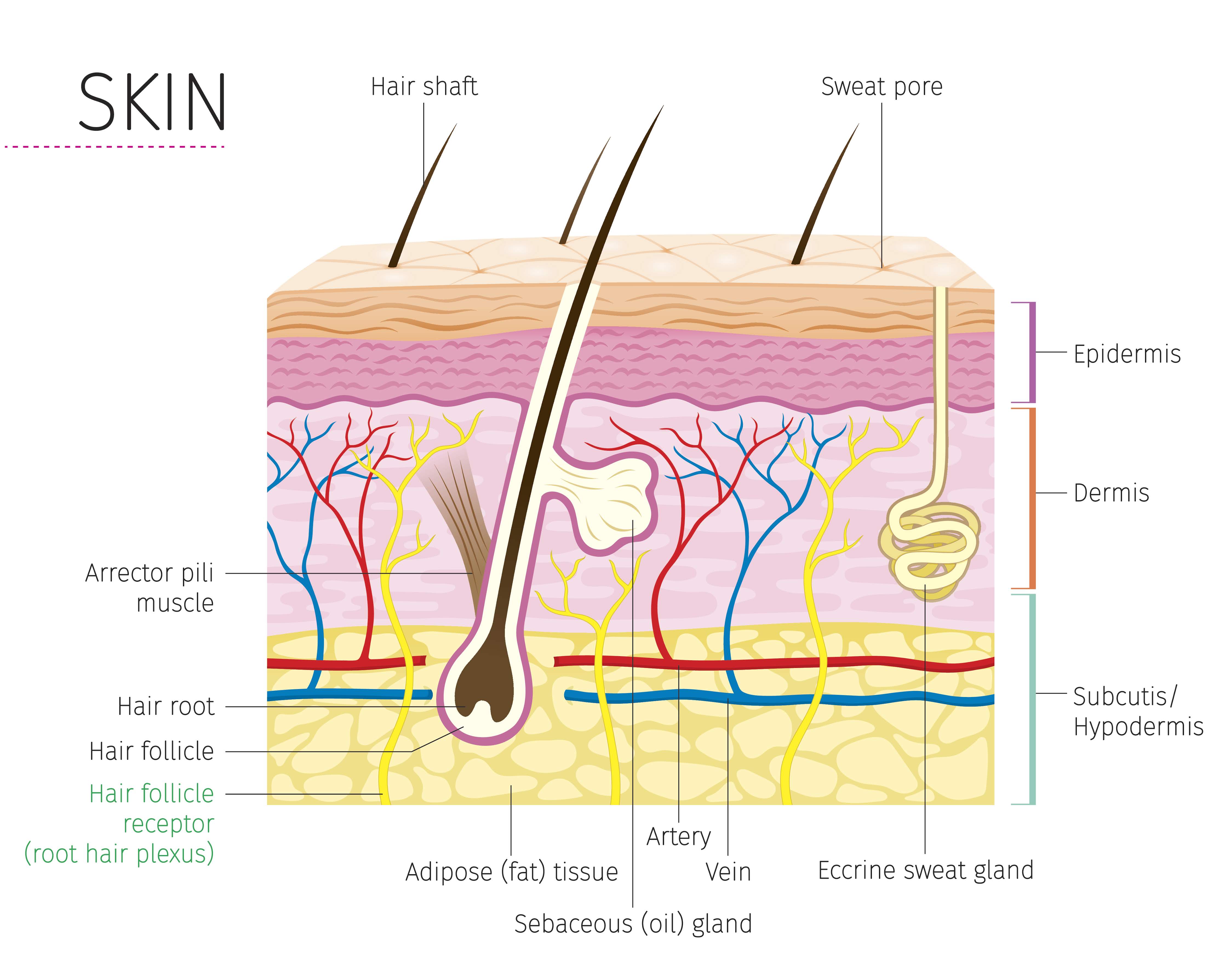
The skin is the cover that shields us from the outside world and protects us again all kinds of outside influences.
The human skin is built in several layers written below:
In below text the following items are discussed:
The epidermis consists for the largest part of one type of cell: the keratinocyt. These cells are formed in the basal layer and slowly move up. Gradually the cells change into a dead horned cellular layer in which the cells lay against each other looser and looser. The connection between the separate epidermic cells is of utmost importance for the protection of the skin again dehydration. Normally spoken this skin is only several tenths of millimetres thick and the horned skin is nothing more than a thin film. In places where the skin contains a lot of callosity (like the palms of your hand and the sole of your foot) the horned skin is extra thick. Because cells continuously divide themselves and peel off at the top, the epidermis renews itself about once a month. The peeling at the surface is usually not visible, except for the haired head at dandruff and certain skin affections like psoriasis.
The epidermis contains besides keratinocyten also melanocyten. The latter are pigment cells that reside between the cells of the basal cellular layer and they produce pigment grains that via sprouts are being transferred to the keratinocyten. The pigment of the pigment grains, melanin, determines for an important part the skin colour and protects the body against sunlight. The more pigment grains, the darker the skin.
The epidermis as a whole forms a natural barrier against chemical substances and physical influences like acids, dehydration and damages by sunlight. The skin also protects us against the penetration of bacteria, moulds and viruses.
The corium of dermis is a 1 to 3 millimetre subcutis layer, which consists mainly of subcutis cells, subcutis fibres and a gel like basic substance.
The bottom of the epidermis and the top of the corium of dermis are not flat. The boundary shows a strong waving pattern with notches and bulges, resulting both layers to gear into each other and the epidermis being rooted in the corium of dermis. The bulges of the corium of dermis into the epidermis are full of tiny little blood veins and lymph veins that feeds the upper layer of the epidermis and transports the by-products. More below in the corium of dermis there is a tight plaiting of larger blood veins and lymph veins. Other nerve fibres maintain the tallow and sweat glands, the muscles around the hairs and the blood veins. The blood veins in the skin are not only responsible for the food and oxygen supply of the skin, but also for controlling the body temperature. The skin saturation of blood determines mainly the amount of heat that is provided to the outside world. The fibres in the skin determine the elasticity and the tractive power of the skin. The older the skin the less elasticity and tractive power. The corium of dermis also contains the nerve ends that provide the touch, the pain and the temperature to the human species.
The lower subcutis contains mainly of grease. It has an important function as warmth isolating layer, energy storage and buffer.
The tallow glands are spread all over the entire skin with the exception of the palms of your hand and the soles of your feet. They are always present beside and discharge into a hair tidy. Tallow consists of a mixture of greasy substances that keep the skin elastic and contain it against dehydration. On average there are a small hundred tallow glands per square centimetre. Midway the chest and back, in the face and on the haired part of the head this number increases to about one thousand per square centimetre. People with high tallow production often have greasy hair.
Sweat glands also are present all over the body and there are several types. The so-called eccrine sweat glands are all over the body and play an important role in controlling the body temperature. In times of emotion and nervousness, the glands in the face and palm of your hands produce a lot of sweat. The sweat glands in the armpits, the so-called apocrine sweat glands, have a different structure and function. In the animal world, these glands play an important role in recognizing and beaconing the territory. With humans, this scent could work sexually stimulating.
We thank the Dutch Organisation of Dermatology and Venereology.





